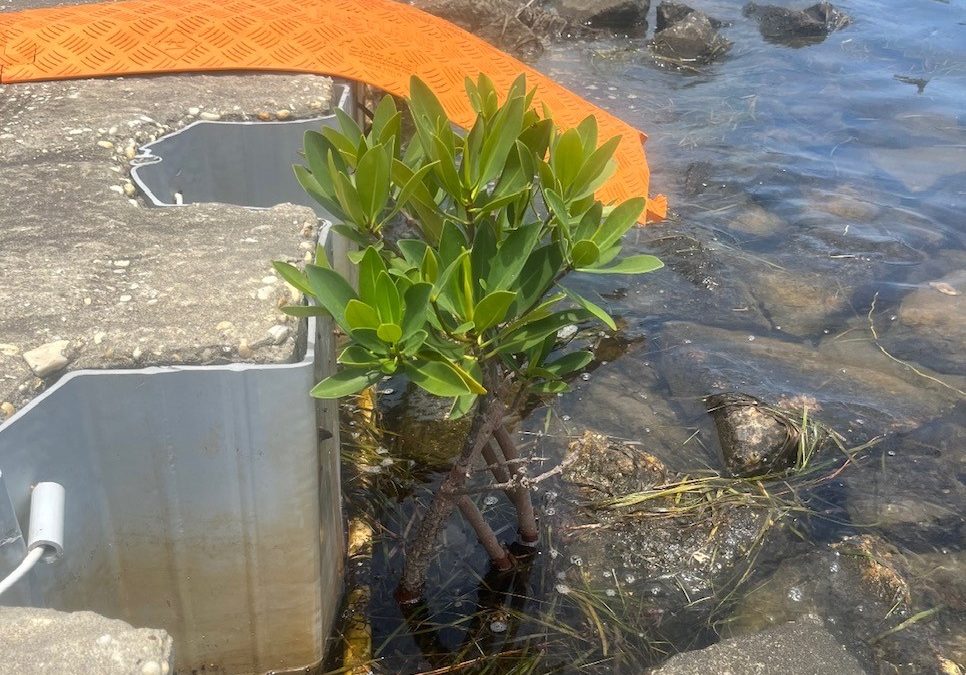
by Rick O'Connor | Jul 29, 2022
Mangroves in the northern Gulf of Mexico are a relatively new thing for most coastal counties. Some residents are aware they are arriving and are not concerned. Some are aware and are actually excited about it. Some are aware and are concerned. Some are not aware. And others have no idea what a mangrove is. Let’s start with that group.

Black mangroves growing near St. George Island in Franklin County.
Photo: Joshua Hodson.
Mangroves are salt tolerant trees that are found all around the globe within the tropics. They grow along the shorelines in areas where they are protected from ocean wind and waves – they like estuaries. There are several species and their location along the shore depends on how long they can be submerged in water. There is a definite zonation of these trees.
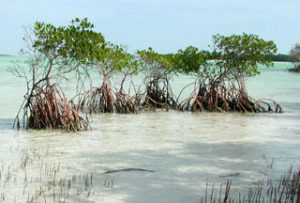
The red mangrove with their distinct prop roots.
Photo: University of Florida
The red mangrove (Rhizophora mangle) is found closest to the waters edge. They can be identified by their prop roots which are designed to keep it standing when the water is moving and shifting the sediment below it. These prop roots also useful during tropical storms when the wave energy increases. The have distinct looking propagules, which are elongated floating seeds which allows the plant to disperse their offspring using the currents and tides. The propagules often wash ashore on northern Gulf beaches but usually in locations not conducive to growth, or they do not survive the winters. These plants can tolerate temperatures in the 30sF for a night or two, but when it drops into the 20sF, and certainly into the 10sF, they will not survive. Despite not being cold tolerant, they have been found growing in the northern Gulf of Mexico. All the mangroves found in the Pensacola area have been of this species.

Black mangroves with their pneumatophores.
Photo: University of Florida
The black mangrove (Avicennia germinans) is found higher in the intertidal zone. It lacks the prop roots of the red but rather has what are called pneumatophores, which resemble the knees of the cypress trees. These pneumatophores have structures that help increase the oxygen uptake for the plant, being that the sediments they live in are quite hypoxic. The seeds of the black mangrove are not elongated but rather resemble a bean. These trees are more tolerant of cold weather than the red mangrove and it is they that have led the march north. There are large stands of these trees in the Apalachicola area as well as barrier islands in Mississippi, Louisiana, and Texas. We have not found a black mangrove growing in Pensacola as of yet.
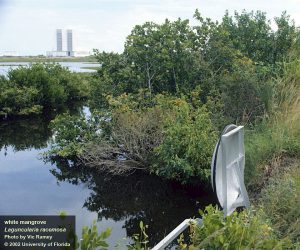
The larger white mangrove.
Photo: University of Florida
White mangroves (Laguncularia racemosa) grow more inland than the other two. This species can grow into a large tree (up to 40 feet). Their leaves can excrete salt allowing them to live in saltier conditions. There are no records of this tree in the northern Gulf of Mexico to my knowledge.
Why would anyone be concerned about mangroves dispersing into the northern Gulf?
Those who are concerned are aware that is a shoreline tree that will grow and possibly block their view of the water. They also are aware that this tree is protected by the state, and they are not allowed to remove or trim the tree without a permit. In south Florida trimming mangroves is allowed in some counties during certain times of the year and only by certified arborist. Those concerned are not excited about potentially loosing their water view.
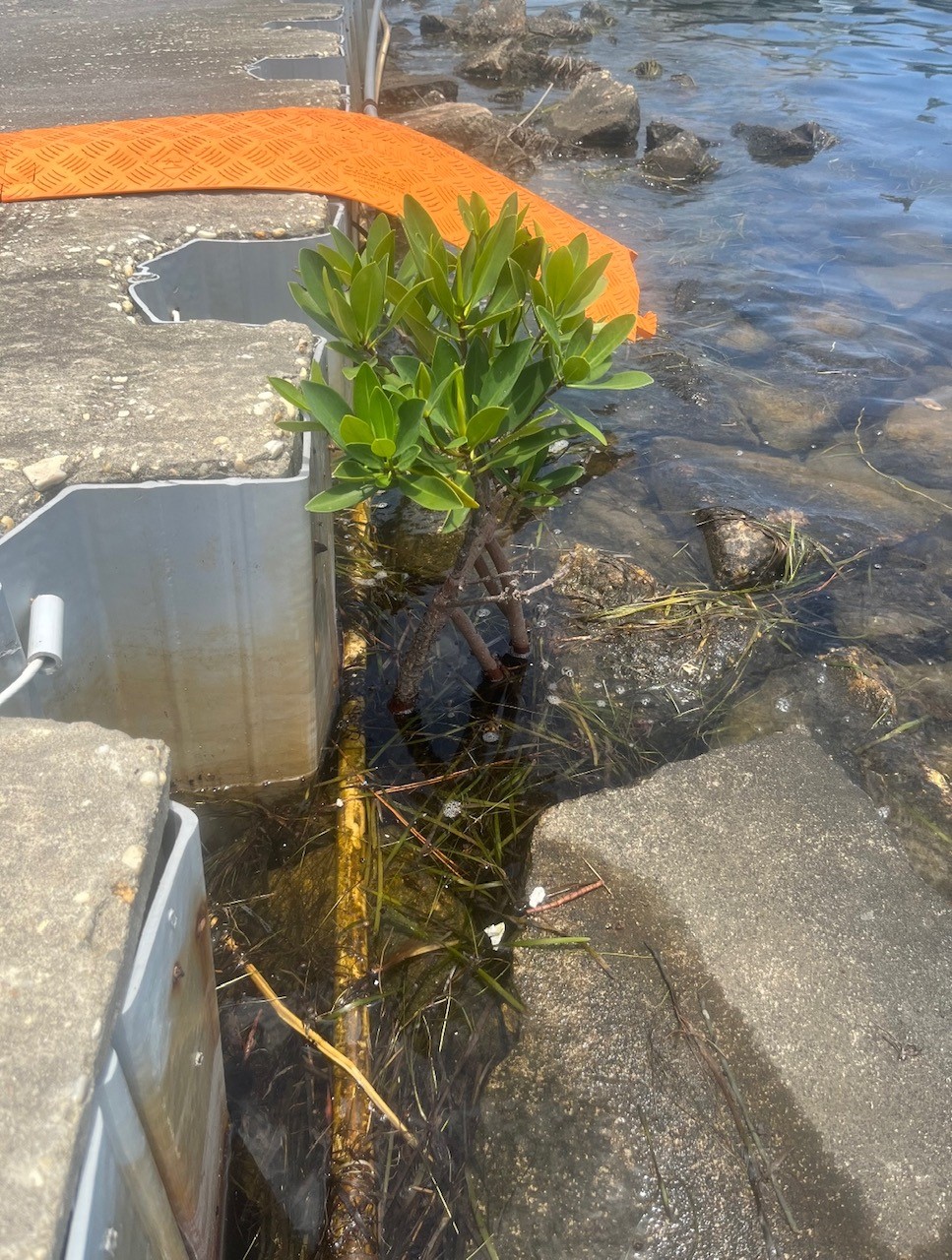
A red mangrove growing near the pass of Pensacola Bay.
Photo: Whitney Scheffel.
Why would anyone be excited about mangroves dispersing into the northern Gulf?
Folks who are excited about the possible coming of the mangroves are so because they have spent time snorkeling and fishing in and around them in more southern locations. The prop roots of the red mangrove create an underwater wonderland of marine life. Small fish, crabs, anemones, starfish, mollusk and more find the large openings formed by the roots as great habitat. These in turn attract larger fish like snook, tarpon, rays, and flounder. Many species of larger fish are popular targets for anglers. Manatees are often found in mangrove swamps grazing on the algae and seagrasses growing nearby and enjoying the relatively calm water. Those who have experienced this in south Florida are excited they may have it here in the north.
How many mangroves, and which species, have dispersed into the northern Gulf is still being studied. Florida Sea Grant has partnered with Mississippi-Alabama Sea Grant and three of the National Estuarine Research Preserves to survey for mangroves in our panhandle counties and along coastal Mississippi and Alabama. Ten transects have identified in each that are surveyed once a year by volunteers using paddle craft. The presence of a mangrove is documented, measured, photographed and shared with the team, which is overseen by Whitney Scheffel of the Pensacola-Perdido Bay Estuary Program. If you are interested in participating in a survey, contact your county Sea Grant Extension Agent.
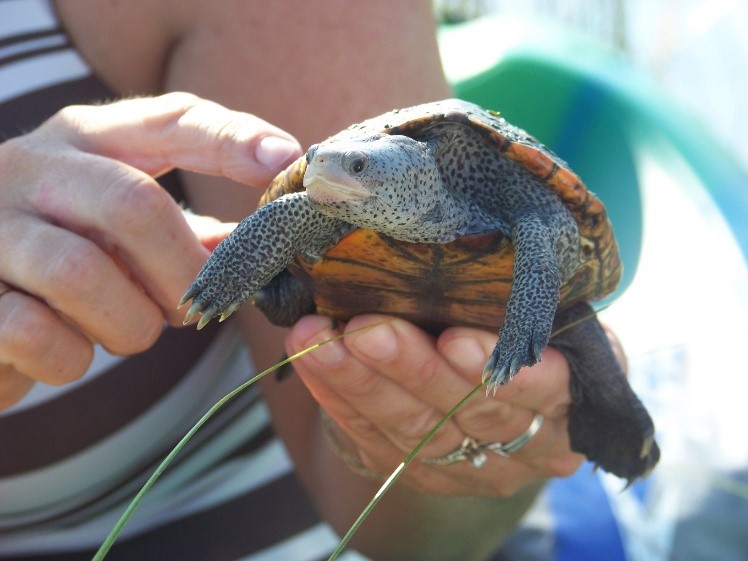
by Ray Bodrey | Apr 17, 2019
Soon, two important ecological surveys will begin in Gulf County, concerning both diamondback terrapins and mangroves.
Florida is home to five subspecies of diamondback terrapin, three of which occur exclusively in Florida. Diamondback terrapins live in coastal marshes, tidal creeks, mangroves, and other brackish or estuarine habitats. However, the diamondback terrapin is currently listed as a Species of Greatest Conservation Need (SGCN).
Diamondback terrapin populations, unfortunately, are nationally in decline. Human activities, such as pollution, land development and crabbing without by-catch reduction devices are often reasons for the decline, but decades ago they were almost hunted to extinction for their tasty meat. The recent decline has raised concern of not only federal agencies, but also organizations and community groups on the state and local levels. Diamondback Terrapin range is thought to have once been all of coastal Florida, including the Keys.
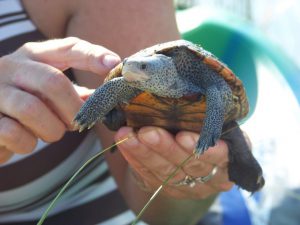
Figure 1: Diamondback Terrapin.
Credit: Rick O’Connor, UF/IFAS Extension & Florida Sea Grant, Escambia County.
Mangroves, a shoreline plant species of south Florida, are migrating north and are now being found in the Panhandle. Both red and black mangroves have been found in St. Joseph Bay. Mangroves establishment could be an important key to a healthy bay ecosystem, as a factor in shoreline restoration and critical aquatic life habitat.
Currently there is a significant data gap for both diamondback terrapin and mangrove populations. Therefore, there is a great need to conduct assessments to learn more about their geographic distribution.
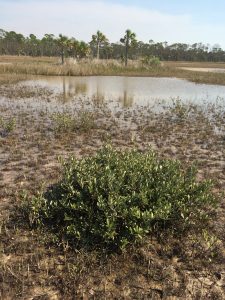
Figure 2. Black Mangrove in St. Joseph Bay.
Credit: Ray Bodrey, UF/IFAS Extension & Florida Sea Grant, Gulf County.
The Forgotten Coast Sea Turtle Center is partnering with UF/IFAS Extension & Florida Sea Grant to assist in surveying and monitoring diamondback terrapins and mangroves in St. Joseph Bay, and we need your help! UF/IFAS Extension & Florida Sea Grant Agent’s Rick O’Connor and Ray Bodrey are providing a training workshop for volunteers and coordinating surveys for St. Joseph Bay. Terrapin surveys require visiting an estuarine location where terrapin nesting sites and mangrove plants are highly probable. Volunteers will visit their assigned locations at least once a week during the months of May and June and complete data sheets for each trip. Each survey takes about two hours, and some locations may require a kayak to reach.
If you are interested in volunteering for these important projects, we will hold a training session on Monday, April 22nd at 1:00 p.m. ET at the Forgotten Coast Sea Turtle Center (located at 1001 10th Street, Port St. Joe).
For more information, please contact:
Ray Bodrey, UF/IFAS Extension Gulf County, Extension Director
rbodrey@ufl.edu
(850) 639-3200
UF/IFAS Extension is an Equal Opportunity Institution.
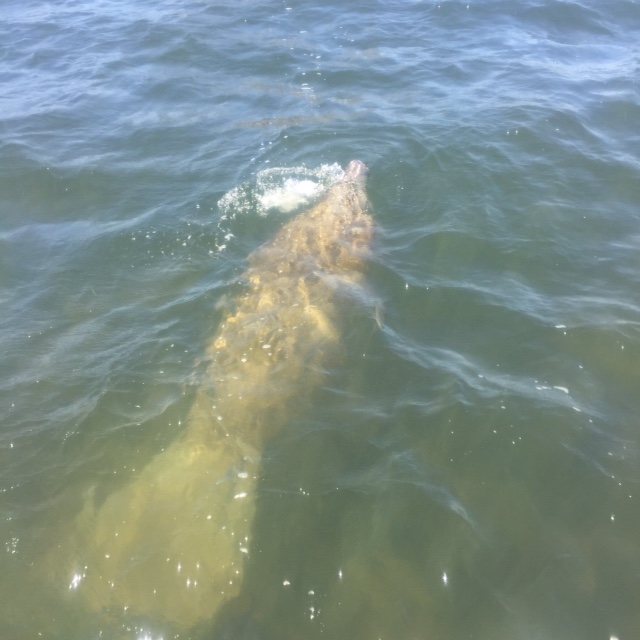
by Rick O'Connor | Feb 16, 2018
As a young boy growing up here in the panhandle, I had heard of this thing called a manatee – but had never seen one. They came more into the light when I was a teenager and becoming interested in marine biology. I was the president of the high school marine biology club and one of our goals was to raise money for a trip to Crystal River to snorkel with them. The Save the Manatee Club originated in that time trying to bring more awareness to the plight of this endangered Floridian and at one point, Jimmy Buffett had led the way.
I had learned a lot about them, found out their original range was from North Carolina south to the Caribbean and the entire Gulf of Mexico, but were now down to about 1000 animals and those were found in Florida. Eventually I did get to see manatees, and have snorkeled with them many times, but still thought of them as a south Florida animal – rarely found in the panhandle.
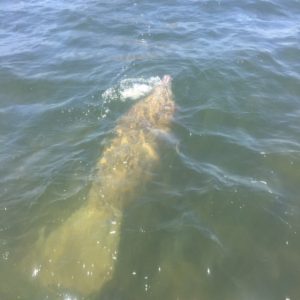
Manatee swimming in Big Lagoon near Pensacola.
Photo: Marsha Stanton
Then the recent news report – two dead manatees in the last two weeks. One washed ashore in Okaloosa county and the other in Escambia. Probably victims of the recent cold fronts. It is not unheard of finding manatees in the panhandle in recent years. I recall since the 1990’s a manatee seen in Bayou Texar in Pensacola. In another year, one was seen near Ft. Pickens. My son worked at a local marina and saw at least one a year there. There have been so many seen in the Mobile Bay area that Dauphin Island Sea Lab now has a Manatee Watch program. There are about 40 individuals that now visit Wakulla Springs. In addition, this summer there were two separate groups living in the Pensacola area. One group was residing near Gulf Breeze and a second group of about eight animals was frequently seen near Perdido Key. These once rare animals in the panhandle are now being found each year, and sometimes in groups.
What is going on?
Why are manatees beginning to visit our area?
Your first hunch would be climate change. Manatees are marine mammals but unlike their dolphin cousins their blubber layer is not as thick and they must seek warm water refuge during the winter months. When water temperatures drop below 67°F, they locate the warm water springs found in central Florida – or move south Florida where the water remains comfortable year round. If they are remaining here, could the average water temperatures have warmed enough for them to make this move?
Along this same line, mangroves are now being found in the panhandle. Both red and black mangroves have been found growing in local estuaries. In the Apalachicola area there have been quite a few located. In the western panhandle there a few individuals here and there. Further west they are found on the islands of Mississippi and have been in the Chandeleurs for many years now. Later this spring Florida Sea Grant will be conducting surveys in each county to see where these tropical trees may be growing.
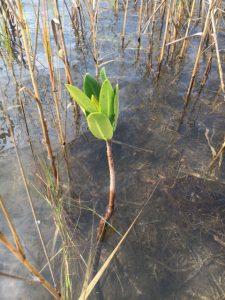
A small red mangrove growing in Big Lagoon near Pensacola FL
Photo: Rick O’Connor
And most recently are sightings of snook, a south Florida fish that have, though rare, been seen in the northern Gulf of Mexico. No doubt this Januarys hard freezes probably killed the mangroves that were here, and probably the two manatees washed ashore recently, but it will be an interesting time to see what other tropical species begin their slow migration northward. If it does happen, what will that mean? How will these changes impact local ecosystems? At this point, I am not sure if it will happen or, if it does, how fast – but it will be interesting.












